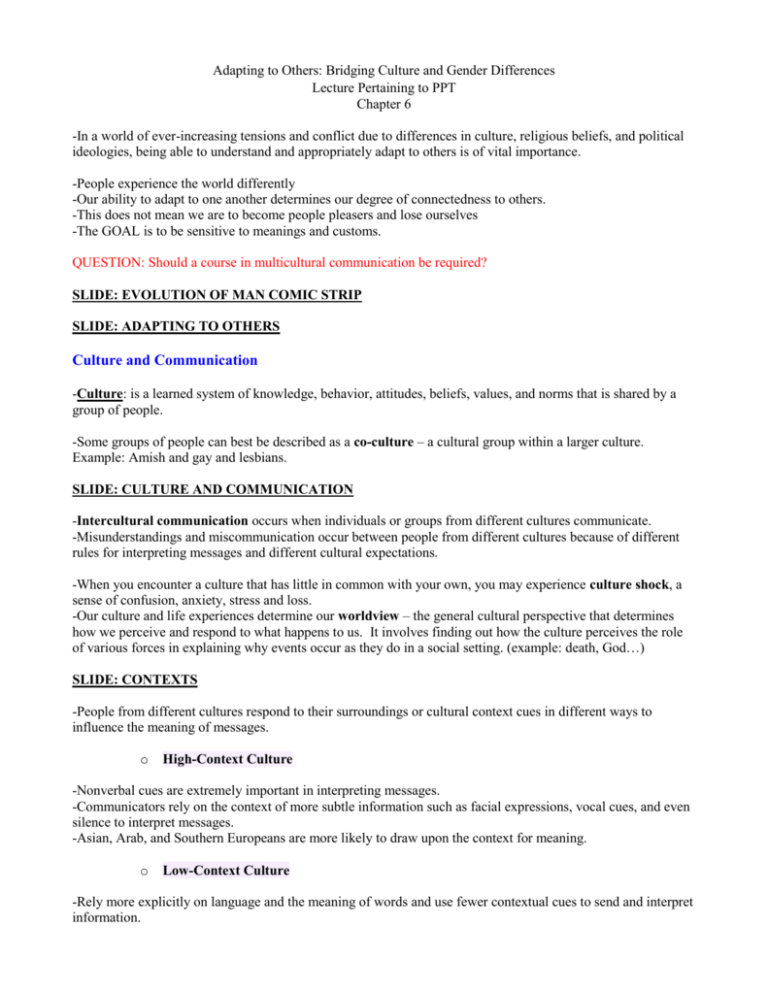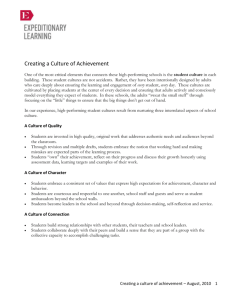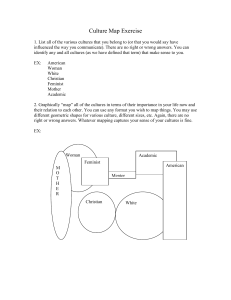Adapting to Others: Bridging Cultural & Gender Gaps
advertisement

Adapting to Others: Bridging Culture and Gender Differences Lecture Pertaining to PPT Chapter 6 -In a world of ever-increasing tensions and conflict due to differences in culture, religious beliefs, and political ideologies, being able to understand and appropriately adapt to others is of vital importance. -People experience the world differently -Our ability to adapt to one another determines our degree of connectedness to others. -This does not mean we are to become people pleasers and lose ourselves -The GOAL is to be sensitive to meanings and customs. QUESTION: Should a course in multicultural communication be required? SLIDE: EVOLUTION OF MAN COMIC STRIP SLIDE: ADAPTING TO OTHERS Culture and Communication -Culture: is a learned system of knowledge, behavior, attitudes, beliefs, values, and norms that is shared by a group of people. -Some groups of people can best be described as a co-culture – a cultural group within a larger culture. Example: Amish and gay and lesbians. SLIDE: CULTURE AND COMMUNICATION -Intercultural communication occurs when individuals or groups from different cultures communicate. -Misunderstandings and miscommunication occur between people from different cultures because of different rules for interpreting messages and different cultural expectations. -When you encounter a culture that has little in common with your own, you may experience culture shock, a sense of confusion, anxiety, stress and loss. -Our culture and life experiences determine our worldview – the general cultural perspective that determines how we perceive and respond to what happens to us. It involves finding out how the culture perceives the role of various forces in explaining why events occur as they do in a social setting. (example: death, God…) SLIDE: CONTEXTS -People from different cultures respond to their surroundings or cultural context cues in different ways to influence the meaning of messages. o High-Context Culture -Nonverbal cues are extremely important in interpreting messages. -Communicators rely on the context of more subtle information such as facial expressions, vocal cues, and even silence to interpret messages. -Asian, Arab, and Southern Europeans are more likely to draw upon the context for meaning. o Low-Context Culture -Rely more explicitly on language and the meaning of words and use fewer contextual cues to send and interpret information. -North Americans or people from Germany or Scandinavia may perceive high-context people as less attractive, knowledgeable, and trustworthy. SLIDE: CULTURE VALUES -That which a given group of people values or appreciates. -Geert Hofstede identified four categories for measuring values that are important for almost every culture. (1) Masculine and feminine perspectives (2) Avoidance of tolerance and uncertainty (3) distribution of power (4) individualism or collectivism. SLIDE: CULUTRAL VALUES: MASCULINE/FEMININE -Some cultures emphasize traditional male values – such as getting things done and being more assertive; other cultures place greater emphasis on traditional female values – building relationships and seeking peace and harmony with others. -Masculine cultures tend to values more traditional roles for men and women, emphasize achievement, assertiveness, heroism, material wealth. -Feminine cultures tend to value caring for the less fortunate, being sensitive toward others. SLIDE: CULTURAL VALUES: INDIVIDUALISM AND COLLECTIVISM -People like to avoid uncertainty and have a general sense for predicting what’s going to happen. Too much uncertainty makes them uncomfortable. -Those cultures in which people need certainty to feel secure are more likely to develop and enforce rigid rules for behavior and establish more elaborate codes of conduct. (Greece, Portugal, and Guatemala) -People from cultures with a greater tolerance for uncertainty have more relaxed, informal expectations for others. (Singapore, Jamaica, and Denmark) Decentralized and Centralized Approaches to Power and Cultural Values -Some cultures are more comfortable with a broad distribution of power. People from such cultures prefer a decentralized approach to power. Leadership is vested in just one person. -Decisions in a culture that values decentralized power distribution are more likely to be made by consensus rather than by decree. -Those cultures that place a high value on centralized power are more comfortable with a militaristic approach to power; centralized power cultures prefer a strongly organized, centrally controlled form of government, as well as managerial styles that feature clear lines of who reports to whom. Individualistic and Collectivistic Cultural Values -Collective cultures champion what people do together and reward group achievement. (Asian cultures) -people try to strive to accomplish goals for the benefit of the group rather than the individual. -Individualistic cultures value individual achievement and personal accomplishments. (North American cultures) -tend to be more loosely knit socially; take care of oneself. SLIDE: GENDER AND COMMUNICATION -One’s gender is learned and socially reinforced by others, as well as by one’s life experiences and genetics. -According to U.S. Bureau of Labor statistics, the civilian workforce was 52% female and 48% male in 1998. Projections suggest that women will soon account for 63% of all employees. The Importance of Gender in Culture -Fascinating research reveals that sex-based expectations and conditioning start practically from birth. -Female babies are held more gingerly; as they become toddlers, they receive more attention from parents when they fall than males. -Males are taught to hide their emotions. -When carried into adulthood, these early sex-based lessons may cause serious harm to our bodies, professional advancement, and relationships. -Women who want to succeed in their careers learn that revealing their emotions isn’t considered professional. -Men find that years of suppressing emotion can lead to health problems and estrangement from family members. Why Women and Men Communicate Versus How -Instrumental orientation: masculine approach that implies action and a “me against the world” view of self. -Feminine cultural values emphasize connecting with others and fostering harmonious relationships, what has been termed an expressive orientation. -Differences in men’s and women’s communication have more to do with why we communicate than how. -Men tend to talk to accomplish something or achieve a task. -Women often use conversation to establish and maintain relationships. -Chapter one described how every message has a content dimension and a relational dimension. -Content dimension: contains what is said or the verbal messages. -Relational dimension: involves how the verbal message is said, including tone of voice, facial expressions, and other nonverbal behaviors. -The content is the what, the relational is the how; the latter aspect tells you how to interpret the former. -Research reveals that men tend to approach communication from a content orientation, meaning that they view communication as functioning primarily for information exchange. -Women, as research suggests, what you talk about is less important than the fact that you’re talking, because talking implies relationship. SLIDE: BARRIERS TO BRIDGING DIFFERENCES -The phrase “battle of the sexes” suggests that men and women perceive and respond to the world differently, which may result in disagreement and evolve into literal battles. -The front pages of our major newspapers continue to chronicle the prevalence of terrorism, war, and conflict around the globe, which are due, in part, to different cultural perspectives. -The first step to bridging differences between people is to identify what hinders effective communication. Sometimes communication falters because of different meanings created by different languages or interpretations of nv messages. Assuming Superiority -Ethnocentrism: is the attitude that our own cultural approaches are superior to those from other cultures. Extreme ethnocentrism is the opposite of being other oriented. -A problem occurs if we become so extremely biased in favor of our own cultural traditions that we fail to recognize that people from other cultural traditions are just as comfortable with their approach to life as we are to ours. Assuming Similarity -It is erroneous to assume that others act and think as you do. Even if they appear to be like you, all people are not alike. -Even when we find a few similarities, we would be in error if we made too many assumptions about our new friend’s attitudes and perceptions. Stereotyping and Prejudice -Rigidly categorizing others and prejudging others based upon limited information. -To stereotype is to push him/her into an inflexible, all encompassing category. -Prejudice: is a judgment we make based on the assumption that we already know all of the information we need to know about a person. -To prejudge someone as inept, inferior, or incompetent based upon that person’s ethnicity, race, sexual orientation, gender, or some other factor is a corrosive force that raises barriers. Different Communication Codes -Differences in language and interpretation of nonverbal cues, leading to misunderstanding. QUESTON: WHEN CAN ETHNOCENTRISM HAVE A POSITIVE EFFECT? (INSPIRES GROUP COHESION/COMPETITION) SLIDE: ADAPTING TO OTHERS Seek Information -Learn about another person’s values, beliefs, and culture Listen and Ask Questions -Reduce uncertainty by asking for clarification and listening to the answer. Tolerate Ambiguity -Take your time and expect some uncertainty. Develop Mindfulness -Be consciously aware of cultural differences, rather than ignoring the differences. Become Other-Oriented -Put yourself in the other person’s mental and emotional frame of mind; socially de-center and develop empathy. o Social Decentering -View the world from another person’s point of view. -Develop an understanding of someone, based on you own past experiences. -Consider what someone may be thinking based on your previous association with him or her. -Consider how most people respond to the situation at hand. o Empathy -Consider what the other person may be feeling. -Stop: avoid focusing only on your own ideas or emotions. -Look: consider nv messages, especially the emotional meaning of messages. -Listen: focus on what the other person says. -Imagine: consider how you would feel. -Paraphrase: summarize your understanding of the thoughts and feelings of your partner. Adapt to Others -Appropriately respond to the messages of others, based upon your understanding of their thoughts (social decentering) and feelings (empathy). DISCUSSION QUESTIONS: Is the United States a tossed salad or a melting pot? The notion of the tossed salad argues that culture like a salad is composed of various ingredients that retain their own individual characteristics, but add to the overall flavor or the course. Is this a good thing? Or should we expect other cultures to blend more with a dominant American culture? What is culture shock? How many live in a dorm? How did you feel the first semester away from home? Is this home sickness or culture shock?







